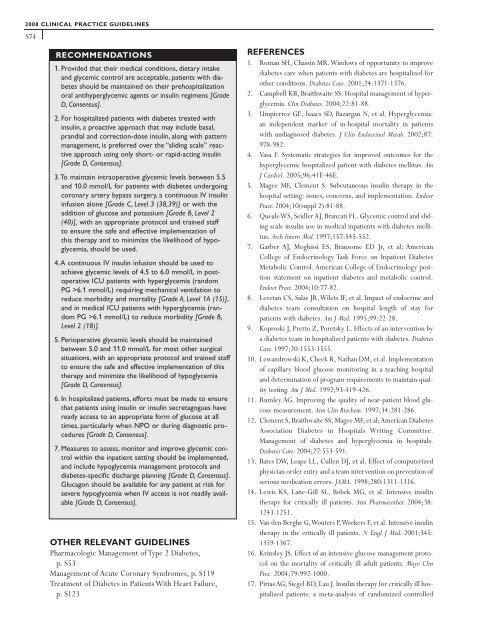2008 Clinical Practice Guidelines - Canadian Diabetes Association
2008 Clinical Practice Guidelines - Canadian Diabetes Association
2008 Clinical Practice Guidelines - Canadian Diabetes Association
Create successful ePaper yourself
Turn your PDF publications into a flip-book with our unique Google optimized e-Paper software.
<strong>2008</strong> CLINICAL PRACTICE GUIDELINES<br />
S74<br />
RECOMMENDATIONS<br />
1. Provided that their medical conditions, dietary intake<br />
and glycemic control are acceptable, patients with diabetes<br />
should be maintained on their prehospitalization<br />
oral antihyperglycemic agents or insulin regimens [Grade<br />
D, Consensus].<br />
2. For hospitalized patients with diabetes treated with<br />
insulin, a proactive approach that may include basal,<br />
prandial and correction-dose insulin, along with pattern<br />
management, is preferred over the “sliding scale” reactive<br />
approach using only short- or rapid-acting insulin<br />
[Grade D, Consensus].<br />
3.To maintain intraoperative glycemic levels between 5.5<br />
and 10.0 mmol/L for patients with diabetes undergoing<br />
coronary artery bypass surgery, a continuous IV insulin<br />
infusion alone [Grade C, Level 3 (38,39)] or with the<br />
addition of glucose and potassium [Grade B, Level 2<br />
(40)], with an appropriate protocol and trained staff<br />
to ensure the safe and effective implementation of<br />
this therapy and to minimize the likelihood of hypoglycemia,<br />
should be used.<br />
4.A continuous IV insulin infusion should be used to<br />
achieve glycemic levels of 4.5 to 6.0 mmol/L in postoperative<br />
ICU patients with hyperglycemia (random<br />
PG >6.1 mmol/L) requiring mechanical ventilation to<br />
reduce morbidity and mortality [Grade A, Level 1A (15)],<br />
and in medical ICU patients with hyperglycemia (random<br />
PG >6.1 mmol/L) to reduce morbidity [Grade B,<br />
Level 2 (18)].<br />
5. Perioperative glycemic levels should be maintained<br />
between 5.0 and 11.0 mmol/L for most other surgical<br />
situations, with an appropriate protocol and trained staff<br />
to ensure the safe and effective implementation of this<br />
therapy and minimize the likelihood of hypoglycemia<br />
[Grade D, Consensus].<br />
6. In hospitalized patients, efforts must be made to ensure<br />
that patients using insulin or insulin secretagogues have<br />
ready access to an appropriate form of glucose at all<br />
times, particularly when NPO or during diagnostic procedures<br />
[Grade D, Consensus].<br />
7. Measures to assess, monitor and improve glycemic control<br />
within the inpatient setting should be implemented,<br />
and include hypoglycemia management protocols and<br />
diabetes-specific discharge planning [Grade D, Consensus].<br />
Glucagon should be available for any patient at risk for<br />
severe hypoglycemia when IV access is not readily available<br />
[Grade D, Consensus].<br />
OTHER RELEVANT GUIDELINES<br />
Pharmacologic Management of Type 2 <strong>Diabetes</strong>,<br />
p. S53<br />
Management of Acute Coronary Syndromes, p. S119<br />
Treatment of <strong>Diabetes</strong> in Patients With Heart Failure,<br />
p. S123<br />
REFERENCES<br />
1. Roman SH, Chassin MR.Windows of opportunity to improve<br />
diabetes care when patients with diabetes are hospitalized for<br />
other conditions. <strong>Diabetes</strong> Care. 2001;24:1371-1376.<br />
2. Campbell KB, Braithwaite SS. Hospital management of hyperglycemia.<br />
Clin <strong>Diabetes</strong>. 2004;22:81-88.<br />
3. Umpierrez GE, Isaacs SD, Bazargan N, et al. Hyperglycemia:<br />
an independent marker of in-hospital mortality in patients<br />
with undiagnosed diabetes. J Clin Endocrinol Metab. 2002;87:<br />
978-982.<br />
4. Vasa F. Systematic strategies for improved outcomes for the<br />
hyperglycemic hospitalized patient with diabetes mellitus. Am<br />
J Cardiol. 2005;96:41E-46E.<br />
5. Magee MF, Clement S. Subcutaneous insulin therapy in the<br />
hospital setting: issues, concerns, and implementation. Endocr<br />
Pract. 2004;10(suppl 2):81-88.<br />
6. Queale WS, Seidler AJ, Brancati FL. Glycemic control and sliding<br />
scale insulin use in medical inpatients with diabetes mellitus.<br />
Arch Intern Med. 1997;157:545-552.<br />
7. Garber AJ, Moghissi ES, Bransome ED Jr, et al; American<br />
College of Endocrinology Task Force on Inpatient <strong>Diabetes</strong><br />
Metabolic Control. American College of Endocrinology position<br />
statement on inpatient diabetes and metabolic control.<br />
Endocr Pract. 2004;10:77-82.<br />
8. Levetan CS, Salas JR,Wilets IF, et al. Impact of endocrine and<br />
diabetes team consultation on hospital length of stay for<br />
patients with diabetes. Am J Med. 1995;99:22-28.<br />
9. Koproski J, Pretto Z, Poretsky L. Effects of an intervention by<br />
a diabetes team in hospitalized patients with diabetes. <strong>Diabetes</strong><br />
Care. 1997;20:1553-1555.<br />
10. Lewandrowski K, Cheek R, Nathan DM, et al. Implementation<br />
of capillary blood glucose monitoring in a teaching hospital<br />
and determination of program requirements to maintain quality<br />
testing. Am J Med. 1992;93:419-426.<br />
11. Rumley AG. Improving the quality of near-patient blood glucose<br />
measurement. Ann Clin Biochem. 1997;34:281-286.<br />
12. Clement S, Braithwaite SS, Magee MF, et al;American <strong>Diabetes</strong><br />
<strong>Association</strong> <strong>Diabetes</strong> in Hospitals Writing Committee.<br />
Management of diabetes and hyperglycemia in hospitals.<br />
<strong>Diabetes</strong> Care. 2004;27:553-591.<br />
13. Bates DW, Leape LL, Cullen DJ, et al. Effect of computerized<br />
physician order entry and a team intervention on prevention of<br />
serious medication errors. JAMA. 1998;280:1311-1316.<br />
14. Lewis KS, Lane-Gill SL, Bobek MG, et al. Intensive insulin<br />
therapy for critically ill patients. Ann Pharmacother. 2004;38:<br />
1243-1251.<br />
15. Van den Berghe G,Wouters P,Weekers F, et al. Intensive insulin<br />
therapy in the critically ill patients. N Engl J Med. 2001;345:<br />
1359-1367.<br />
16. Krinsley JS. Effect of an intensive glucose management protocol<br />
on the mortality of critically ill adult patients. Mayo Clin<br />
Proc. 2004;79:992-1000.<br />
17. Pittas AG, Siegel RD, Lau J. Insulin therapy for critically ill hospitalized<br />
patients: a meta-analysis of randomized controlled











